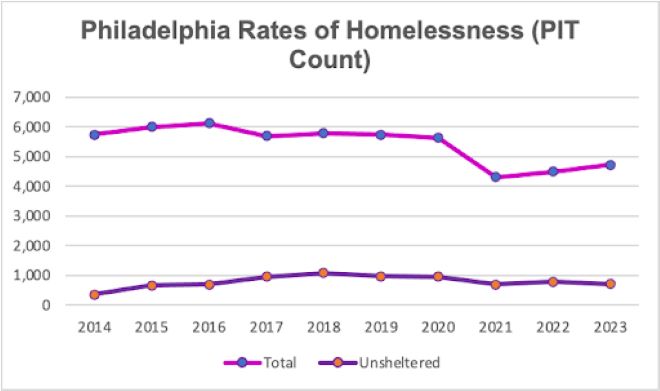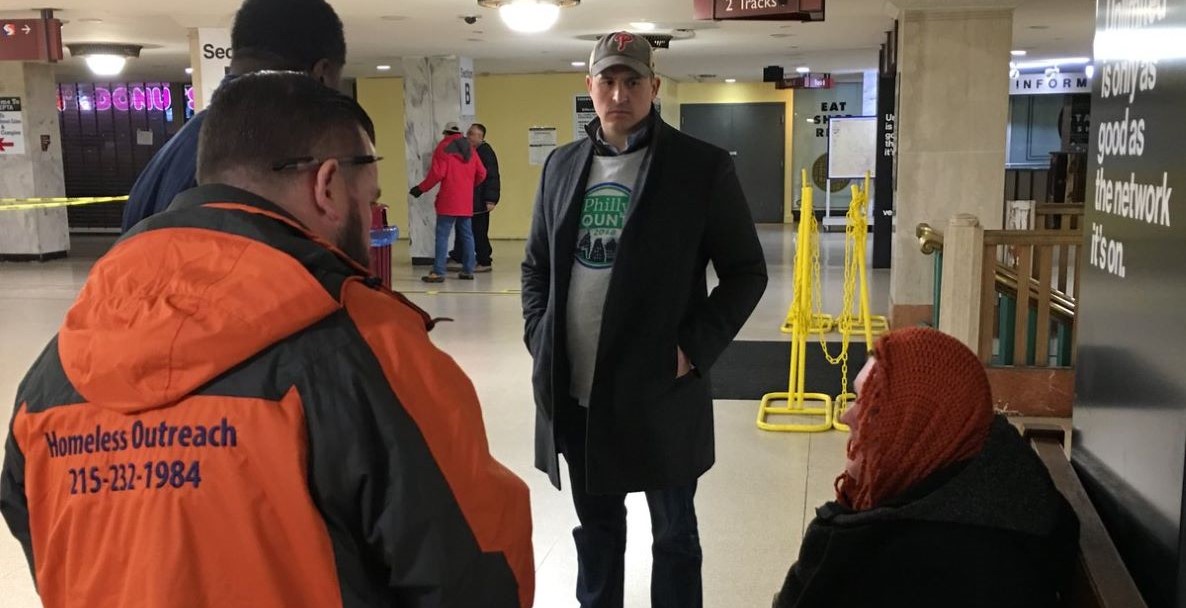On a weekend in late January, I gathered with over 100 volunteers at LOVE Park among heated tents and free coffee, to help with the annual count of Philadelphia’s homeless population. Each year, the Office of Homeless Services conducts this Point In Time (PIT) count, to attempt to determine the state of homelessness in the city, and how best to address it.
But even as I headed out to help, I wondered: to what end?
Prior to the gathering, I spoke to dozens of volunteers who actively work with homeless populations in Philadelphia. Nearly every one believes the count every year to be considerably off, to the point of being entirely unreliable. Several conversations I’ve had since, including with the Department of Housing and Urban Development and researchers at Jefferson University, have further reinforced my belief. In fact, Philadelphia’s annual erroneous count may be the one thing that nearly everyone seems to agree on.
But if this is the case, by how much, and why are we still doing it?
How we count people
The Point in Time Count is broken up into two categories: sheltered, and unsheltered. The sheltered count is ostensibly straightforward; Volunteers count the total number of individuals staying overnight in a shelter in a particular jurisdiction. For the unsheltered count, volunteers depart in groups to walk around assigned streets overnight, counting each homeless individual they see, and asking willing respondents a series of demographic questions.
The Department of Housing and Urban Development (HUD) determines the guidelines and standards for the PIT. Each year every Continuum of Care (CoC) — the planning body that runs a PIT count; Philadelphia’s CoC is the Office of Homeless Services — must run their count to HUD’s standards. According to HUD, the count must always occur within the last 10 days of January to ensure continuity.
The purpose of these counts is multifaceted. Largely, they influence federal spending allocations. While there are numerous methodological criticisms of the PIT, the overall objective is important: Before any funding to address homelessness can happen, we need to first understand the scope of — the numbers behind — the problem, and any attempt to truly tackle homelessness in our city is impossible without it.
I spoke to dozens of volunteers who actively work with homeless populations in Philadelphia. Nearly every one believes the count every year to be considerably off, to the point of being entirely unreliable.
But in Philadelphia, the January timeframe is part of the problem. Trying to come up with an accurate count of unsheltered homeless people is impossible during what’s invariably one of the coldest nights of the year, when extreme conditions compel many people experiencing homelessness to find some form of temporary shelter apart from the shelter system.
HUD’s Point in Time Count Methodology Guide provides several reasons for a January count. They say counting in winter months raises awareness of the plight of the homeless and therefore makes it easier to get volunteers. They claim choosing a single date early in the year both allows CoCs to provide HUD with consistent data across the country and gives them room to process in time for the annual CoC program competition. In addition, the guide says it’s easier to count people in winter, when shelters are fuller. Despite these numerous reasons, the section ends with a disclaimer that “a January PIT count is not intended to represent the extent to which people may be unsheltered at other times during the year or over more than a one-night period.”
The flaws of the PIT count
Of the reasons provided for a January count, nearly all are suspect. The rationale for winter months raising awareness and thus volunteers is purely heuristic, not supported by any available data. Further, depending on the weather, unsheltered individuals who would sleep on the street or in alleyways during warmer months may find alternative shelter that is not easily accessible to those conducting the count, such as hospital waiting rooms or friends’ couches. And, weather conditions across the U.S. in the month of January are not uniform, with temperatures in Miami in January typically range within the mid to low 60s, whereas in Philadelphia, they average below freezing.
When speaking to the HUD representative, I was told that while HUD deliberately avoids comparisons between jurisdictions, these numbers do contribute to their overall totals, which allows them to understand the scope of the issue. Thus, it remains difficult to see how uniformity can be maintained in aggregate given these discrepancies in conditions.
Similarly, the interest of accuracy is difficult to maintain when examining the perverse incentive that results from reductions in reported homelessness. Each year, CoC’s report data to HUD for an annual program competition that determines funding. Each CoC is in competition with each other to achieve the maximum total points, which can be awarded for achieving certain objectives like partnering with local health agencies (5 points) or increasing the affordable housing supply (1 point). The more points awarded to a CoC, the more funding allocated. Out of the 200 points that it is possible to award, reducing the number of homeless individuals per the PIT Count composes 5 percent, or 10 points. Thus, in a system in which every point counts, CoC’s need to reduce their numbers each year, leading to a system that favors a low count over accuracy.
In 2022 HUD reported around 582,500 individuals experiencing homelessness in the United States, whereas the Department of Education reported 1.2 million homeless students in the school year of 2021-2022.
Counting people on the streets and in shelters has never given an accurate assessment of the problem. The count often misses families experiencing homelessness, as most homeless families and youth avoid sleeping in shelters or on the streets due to the inherent danger, as well as fear of having children removed by child welfare agents.
Further, according to Tom Frey, a homeless advocacy volunteer and organizing director of the Everywhere Project, during winter months shelters in the city frequently reach capacity and thus the advantages of counting those in shelters are minimized as it is more a reflection of the city’s overall capacity for shelter beds, rather than a way of determining how many homeless individuals there are.
For context on the discrepancy: In 2022 HUD reported around 582,500 individuals experiencing homelessness in the United States, whereas the Department of Education reported 1.2 million homeless students in the school year of 2021-2022.
Perhaps the most damning criticism of the PIT is that it does not track individuals without permanent housing who are “doubled up” or staying with family members or friends temporarily. According to methods produced by the Chicago Coalition for the Homeless, in 2019, as many as 3.7 million Americans were doubled up, a far cry from the 568,000 reported by HUD that same year.
Under-resourced, underestimated
To HUD’s credit, their position is entirely understandable. HUD receives a small overall budget for their scope, and the vast majority goes to rent assistance. Having a more accurate count will require a great deal more money that could be going toward greater services to those that need it, and the time and resources required to account for doubled up homeless individuals and to identify the full scope of homelessness would certainly be expensive.
Per the HUD representative I spoke with, “From a pragmatic standpoint it’s completely unfeasible,” adding that in terms of funding, “We get almost nothing for our CoCs.” This pragmatic reality may be the cause of undercounting, but this is exactly why there needs to be greater funding across the board. Addressing homelessness necessitates understanding its full scope, but that requires real funding and support to both HUD, and the CoCs that support it.
Whatever the source of the problem, undercounting kills.
If the goal of the count is accurately understanding the problem, then failing to account for these shortcomings means less funding for those who need it most. While the problems stem from HUD, the City’s Office of Homeless Services is not without reproach. It is extremely unlikely that these numbers are viewed by anyone as a source of credible information and has been subject to severe criticism by government watchdog organizations.
The Government Accountability Office in a scathing review published in 2020, stated that “the PIT Count — particularly the unsheltered PIT count — likely underestimates the number of people experiencing homelessness at the time of the count.” So why is the City’s Office of Homeless Services still standing by these numbers?
The city reported 4,725 total homeless individuals in 2023, a number that has steadily fallen over the last 10 years. Activists say the real numbers are significantly higher. But there is no definitive way to say. And that’s exactly the problem. Without robust and broadly accepted standards, we can’t begin to tackle this important challenge.

Where there’s a will …
As I was standing out on that cold rainy night listening to a seemingly endless stream of speakers, one caught my ear. Adam Thiel, City’s Managing Director, expressed the Parker administration’s strong desire to work on an intergovernmental basis to address this ongoing crisis. I hope that he and the Parker administration truly mean it. To do so, Philadelphia needs to be the advocate for reforming the Point in Time Count and needs to pressure our own legislators to demand reform for homelessness statistics and federal funding.
Alternative methods of determining homeless populations such as a By Name List, in which individuals experiencing homelessness are tabulated monthly on an internal list put together by communities is certainly one way forward, and has been demonstrated to work in communities across the US, especially in regard to identifying individuals who have been doubled up. In Bakersfield California, incorporating a By Name List helped officials to better target resources more efficiently, ultimately assisting in achieving a functional zero for chronic homelessness in 2020.
Another alternative developed by researchers in 2019 uses census micro-data to estimate the number of doubled-up homeless individuals in a given area, and is currently being used by the Chicago Coalition for the Homeless each year to determine the rates of homelessness in Chicago. Unfortunately, neither the By Name List, nor the census micro-data method are accepted as a methodology by HUD to report official numbers for the purposes of federal funding, but alternatives such as these can allow cities to understand where funding gaps are present, and make better use of their existing resources.
As a city we cannot continue to keep passing the buck. Philadelphia, while not having an especially high homeless population compared to other major cities, has unique struggles which have made it especially prominent within the news and the public’s imagination. The reality is, whatever the source of the problem, undercounting kills — and the City of Brotherly Love cannot stand by and watch it continue.
Jacob Fuller is an activist, former political staffer and policy writer based in Philadelphia. He has served as a campaign manager and staffer to multiple political campaigns and volunteers in his spare time.
The Citizen welcomes guest commentary from community members who represent that it is their own work and their own opinion based on true facts that they know firsthand.
![]() MORE FROM THE CITIZEN ON HOUSING AND THE HOMELESS
MORE FROM THE CITIZEN ON HOUSING AND THE HOMELESS



